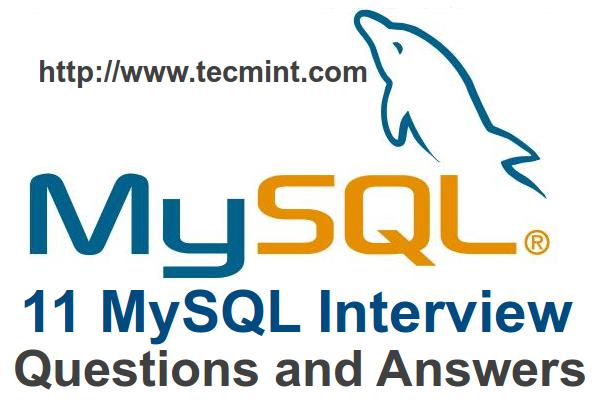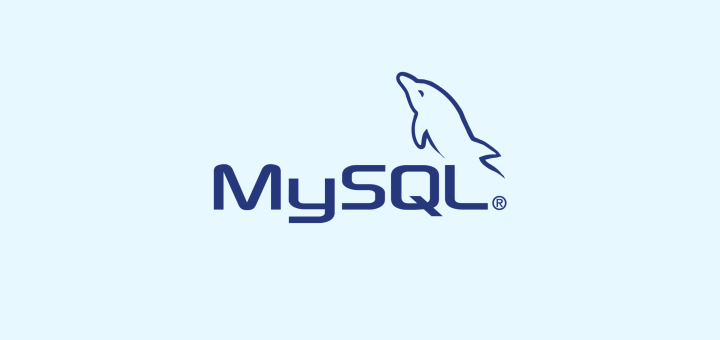We have already published two MySQL articles, well appreciated by Tecmint Community. This is the third article on MySQL Interview series and sixteen in the the Interview Genre Column.

We have reached here all because of yours support and we seek the same in future form your end. Here in this article we will be concentrating on the practical aspect of MySQL, the question relevant for Interview aspect.
1. Using SELECT statement find the version of the server you are running and print the name of the current database?
Ans: The below MySQL command will show server version and currently selected Database.
mysql> SELECT VERSION(), DATABASE(); +-------------------------+------------+ | VERSION() | DATABASE() | +-------------------------+------------+ | 5.5.34-0ubuntu0.13.10.1 | NULL | +-------------------------+------------+ 1 row in set (0.06 sec)
In the Database Column it is showing NULL value because we have not selected any database. So, select database as shown in the following command.
mysql> use Tecmint; Reading table information for completion of table and column names You can turn off this feature to get a quicker startup with -A Database changed
mysql> select VERSION(), DATABASE(); +-------------------------+------------+ | VERSION() | DATABASE() | +-------------------------+------------+ | 5.5.34-0ubuntu0.13.10.1 | tecmint | +-------------------------+------------+ 1 row in set (0.00 sec)
2. USE NOT Operator (!) to select all the users except ‘SAM’ from a table say ‘Tecmint’
Ans: The below statement will show all the columns of all the users from table ‘Tecmint‘ except the user ‘SAM‘.
mysql> SELECT * FROM Tecmint WHERE user !=SAM; +---------------------+---------+---------+---------+---------+-------+ | date | user | host | root | local | size | +---------------------+---------+---------+---------+---------+-------+ | 2001-05-14 14:42:21 | Anthony | venus | barb | venus | 98151 | | 2001-05-15 08:50:57 | TIM | venus | phil | venus | 978 | +---------------------+---------+---------+---------+---------+-------+
3. Is it possible to implement ‘AND’ with NOT (!) Operator.
Ans: The AND operator is used when we use (=) and the operator OR is used when we use (!=). An example of (=) with AND Operator.
mysql> SELECT * FROM mail WHERE user = SAM AND root = phil
An Example of (!=) with OR Operator.
mysql> SELECT * FROM mail WHERE user != SAM OR root != phil +---------------------+---------+---------+---------+---------+-------+ | date | user | host | root | local | size | +---------------------+---------+---------+---------+---------+-------+ | 2001-05-14 14:42:21 | Anthony | venus | barb | venus | 98151 | +---------------------+---------+---------+---------+---------+-------+
- = : means Equal to
- != : Not Equal to
- ! : represents NOT Operator
The AND & OR are treated as joining operators in MySQL.
4. What IFNULL() statement is used for in MySQL?
Ans: The Query in MySQL can be written precisely using IFNULL() statement. The IFNULL() statement test its first argument and returns if it’s not NULL, or returns its second argument, otherwise.
mysql> SELECT name, IFNULL(id,'Unknown') AS 'id' FROM taxpayer; +---------+---------+ | name | id | +---------+---------+ | bernina | 198-48 | | bertha | Unknown | | ben | Unknown | | bill | 475-83 | +---------+---------+
5. You want to see only certain rows from a result set from the beginning or end of a result set. How will you do it?
Ans: We need to use LIMIT clause along with ORDER BY to achieve the above described scenario.
Show 1 Record
mysql> SELECT * FROM name LIMIT 1; +----+------+------------+-------+----------------------+------+ | id | name | birth | color | foods | cats | +----+------+------------+-------+----------------------+------+ | 1 | Fred | 1970-04-13 | black | lutefisk,fadge,pizza | 0 | +----+------+------------+-------+----------------------+------+
Show 5 Record
mysql> SELECT * FROM profile LIMIT 5; +----+------+------------+-------+-----------------------+------+ | id | name | birth | color | foods | cats | +----+------+------------+-------+-----------------------+------+ | 1 | Fred | 1970-04-13 | black | lutefisk,fadge,pizza | 0 | | 2 | Mort | 1969-09-30 | white | burrito,curry,eggroll | 3 | | 3 | Brit | 1957-12-01 | red | burrito,curry,pizza | 1 | | 4 | Carl | 1973-11-02 | red | eggroll,pizza | 4 | | 5 | Sean | 1963-07-04 | blue | burrito,curry | 5 | +----+------+------------+-------+-----------------------+------+
mysql> SELECT * FROM profile ORDER BY birth LIMIT 1; +----+------+------------+-------+----------------+------+ | id | name | birth | color | foods | cats | +----+------+------------+-------+----------------+------+ | 9 | Dick | 1952-08-20 | green | lutefisk,fadge | 0 | +----+------+------------+-------+----------------+------+
6. Oracle Vs MySQL. Which one and Why?
Ans: Well both has its advantages and disadvantages. As a matter of time I prefer MySQL.
Reason for Selection MySQL Over oracle
- Mysql is FOSS.
- MySQL is portable.
- MYSQL supports both GUI as well as Command Prompt.
- MySQL Administration is supported over Query Browser.
7. How will you get current date in MySQL?
Ans: Getting current date in MySQL is as simple as executing the below SELECT Statement.
mysql> SELECT CURRENT_DATE(); +----------------+ | CURRENT_DATE() | +----------------+ | 2014-06-17 | +----------------+
8. How will you export tables as an XML file in MySQL?
Ans: We use ‘-e‘ (export) option to export MySQL table or the whole database into an XML file. With large tables we may need to implement it manually but for small tables, applications like phpMyAdmin can do the job.
A native command of MySQL can do it.
mysql -u USER_NAME –xml -e 'SELECT * FROM table_name' > table_name.xml
Where USER_NAME is username of Database, table_name is the table we are exporting to XML and table_name.xml is the xml file where data is stored.
9. What is MySQL_pconnect? And how it differs from MySQL_connect?
Ans: MySQL_pconnect() opens a connection that is persistent to the MySQL Database which simply means that the database is not opened every-time the page loads and hence we can not use MySQL_close() to close a persistent connection.
A brief difference between MySQL_pconnect and MySQL_connect are.
Unlike MySQL_pconnect, MySQL_connect – Opens the Database every-time the page is loaded which can be closed any-time using statement MySQL_close().
10. You need to show all the indexes defined in a table say ‘user’ of Database say ‘mysql’. How will you achieve this?
Ans: The following command will show all the indexes of a table ‘user’.
mysql> show index from user; +-------+------------+----------+--------------+-------------+-----------+-------------+----------+--------+------+------------+---------+---------------+ | Table | Non_unique | Key_name | Seq_in_index | Column_name | Collation | Cardinality | Sub_part | Packed | Null | Index_type | Comment | Index_comment | +-------+------------+----------+--------------+-------------+-----------+-------------+----------+--------+------+------------+---------+---------------+ | user | 0 | PRIMARY | 1 | Host | A | NULL | NULL | NULL | | BTREE | | | | user | 0 | PRIMARY | 2 | User | A | 4 | NULL | NULL | | BTREE | | | +-------+------------+----------+--------------+-------------+-----------+-------------+----------+--------+------+------------+---------+---------------+ 2 rows in set (0.00 sec)
11. What are CSV tables?
Ans: CSV stands for Comma-Separated Values aka Character-Separated Values. CSV table stores data in plain text and tabular format. It typically contains one record per line.
Each record is separated by specific delimiters (Comma, Semi-colon, …) where each record has same sequence of field. CSV tables are most widely used to store phone contacts to Import and Export and can be used to store any sort of plain text data.
That’s all for now. I’ll be here again with another Interesting article, you people will love to read. Till then stay tuned and connected to Tecmint and Don’t forget to provide us with your valuable feedback in the comment section below.







Very Nice Post sir..
It was very helpful for me for crack MySql Interview.
Thanks For Share It was Very Helpful.
Regards,
Mahesh
Thanks this will be very helpful for my up coming interview.
it is very help full contents.
thanks for updating this content.
The command to extract xml is by either using -X flag; or use –xml (two dashes)
Thank you. it is really helpful. Keep posting these kind of valuable interview questions. it really helps
Number 3 is actually wrong.
Your logic is X AND Y == !X OR !Y
When it should actually be X AND Y == !(!X OR !Y)
hello this is really very good content …………….but sir i want more specific which help me to use with my php code….thanks
Dear DJ_HITMAN,
If you have to ask any question not relataed to above topic, you may ask it at linuxsay.com.
linuxsay.com is a forum of ours where you can get solution to your problems.
It’s very useful…Thanks.
Welcome Shailesh, Keep Connected!
Hi sir,
i am a commerce graduate. but i love computer science. now i am learning mysql Database.
it’s really help.
Thank you very much for sharing this article.
Thanks
G s krishna
Welcome Krishna, keep connected!